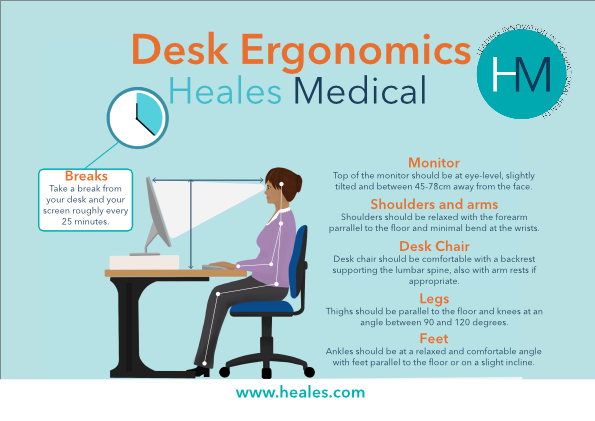

Create a permanent work space
Decide which is your designated work area. If you have space, it might help if it is in a room that you can close the door on while you are working to limit distractions, and at the end of the day to separate work from home life.
Set up your desk correctly
Monitor should be at eye level, slightly tilted upwards and 47-78cm away from your face
Your shoulders should be relaxed with the forearm parallel to the floor and minimial bend at the wrist
Your desk chair should be comfortable with a backrest supporting the lumbar spine, with arm rests if appropriate
Your thighs should be parallel to the floor and knees bent at 90-120 degrees
Ankles should be at a relaxed and comfortable angle with feet parallel to the floor or with a slight incline
Ask for help from IT and colleagues
If something is not working, such as your SIP phone, or access to your work network, call IT or a colleague to help you. Don’t stuggle alone, it is better for you, your colleagues and your work if you are able to work efficiently.

Get ready for the day
Don’t just come to the desk in your pyjamas. After 2 or 3 days you may start to lose your motivation and concentration. Getting ready for the day will help prepare your mind for the work day, and will make sure you’re prepared for impromptu video meetings.
Set your start and end time for the day
Depending on the type of work you’re doing, you may be able to work according to your best time of day. For example, if you are at your best in the morning, and you aren’t taking client calls, ask your manager if you can work 7am-3pm. If you are better in the evening, ask if you can try working 11am-7pm.
Take regular breaks
Take a quick break from your desk and your screen roughly every 25 minutes. Go make a cup of tea, take a walk around the house or garden, or do a set of 5 jumps to get the blood circulating round the body.
Ensure you are getting exercise
Exercise gets the blood flowing to the brain and helps us work better. It improves our mood by releasing endorphines and our concentration by helping us to digest and not get sluggish. It also prevents us developing any musculoskeletal issues from sedentary working. There are plenty of types of exercise you can do from home, remember current government requirements mean we can only go outside to exercise once a day.
Try one of our monthly workouts here.
Prioritise your tasks
It can be easy to become overwhelmed, make a list of all your tasks for the day. Make space for any less time critical tasks after the one you are currently working on, before you start the next time critical task.
Working from home can be isolating, especially if you live alone or live with key workers who are out for long periods of the day.
You can also feel out of step with everyone else you work with. Make sure you are regularly contacting your colleagues and managers so you’re all working from the same page, which will help you to continue feeling part of the team.
Keep work channels clear for work talk
You’ll be missing a lot of instant communication from sitting with your teammates in the office, so start a chat either on your work system’s instant messaging feature, or on a messaging app (the Admin team are using WhatsApp, the Business Development team are using Taskade).
Create social channels too
Let’s be fair, only talking about work with the outside world would make us all feel strange. See if you can create a work chat group to use during lunchtimes and after work for the general banter you’re missing around the office.
Use video conferencing where possible
Video communication helps us to feel connected, and can be really helpful in picking up non verbal cues, particularly in conversations around mental health. The Heales Senior Management Team meet daily over Jitsi to touch base.
Use the support that’s available
Many workplaces have Employee Assistance Programmes or counselling helplines that you can call if you’re feeling low, isolated or having trouble working from home. Use the Health and Wellbeing Portal pages for tips on maintaining physical and mental health, and check out our Stress page if you’re feeling overwhelmed. Let us know if there is any content you wish to see.
At your alloted end of the day, stop.
Full stop
Pack away your desk, close the door to the office or put your laptop in its bag and in the cupboard, disconnect the SIP phone and stop.
It can be really easy, when working from home, to keep going for just a little while longer, and not noticing where the time goes, because you haven’t got to commute. Maintaining a work-life balance is even more crucial when they both happen in the same place, and the lines are more blurred.
Have something fun planned for the end of the day, whether that is watching an episode of your latest boxset, playing with the kids, baking something yummy, painting or learning a new language or skill.
